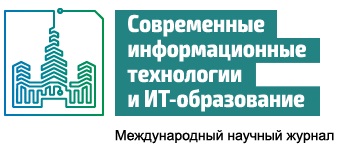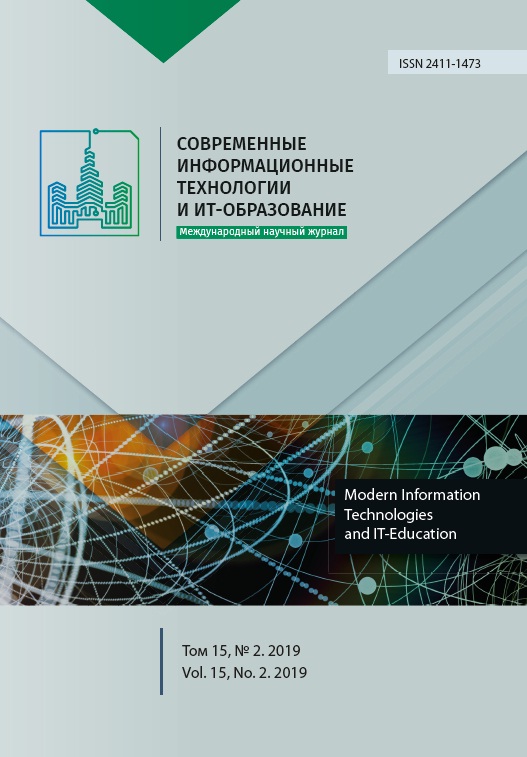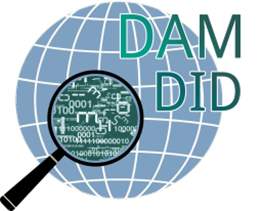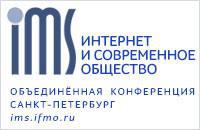Вероятностная модель шумов для периодических символьных последовательностей
Аннотация
В целях анализа методов поиска циклов и выявления их особенностей и чувствительности к шумам различных типов необходимо моделирование шумов с заданными характеристиками. Для построения почти периодических символьных последовательностей предложены две вероятностные модели шума. Модели позволяют вносить в периодическую последовательность различные типы шума, такие как изменение, добавление и удаление символов. Таким образом на основе периодической символьной последовательности получается почти периодическая последовательность.
Необходимо обеспечить заданный уровень шума в построенной почти периодической последовательности. Требуемый уровень вносимого шума гарантирует двухуровневая модель, в которой на первом уровне на основе выбранной исследователем дискретной случайной величины определяются позиции для внесения шума, а на втором уровне с использованием случайной величины, моделирующей собственно шум, в соответствующие позиции вносится необходимое изменение. Вторая модель основана на внесении шума с вероятностью, зависящей от уровня шума, в каждом элементе последовательности.
Наблюдаемый уровень шума рассчитывается на основе расстояния Левенштейна между исходной периодической последовательностью и построенной зашумленной. Наблюдаемый уровень шума всегда несколько меньше уровня вносимого шума, поскольку при вычислении расстояния Левенштейна может быть найден более короткий путь получения зашумленной последовательности из периодической, чем использованный при построении почти периодической последовательности.
Проведено сравнение предложенных моделей по близости обеспечиваемого ими уровня шума к заданному уровню шума. Вычислительный эксперимент показал, что наблюдаемый уровень шума ближе к заданному для двухуровневой модели. Программная реализация данных моделей будет использована в дальнейшем для исследования алгоритмов поиска циклов в зашумленных периодических символьных последовательностях.
Литература
(In Eng.) DOI: 10.1109/ICDE.2001.914829
[2] He Z., Wang X.S., Lee B.S., Ling A.C.H. Mining Partial Periodic Correlations in Time Series. Knowledge and Information Systems. 2008; 15(1):31-54. (In Eng.) DOI: 10.1007/s10115-006-0051-5
[3] Elfeky M.G., Aref W.G., Elmagarmid A.K. Periodicity Detection in Time Series Databases. IEEE Transactions on Knowledge and Data Engineering. 2005; 17(7):875-887. (In Eng.) DOI: 10.1109/TKDE.2005.114
[4] Kung-JiuanYang, Tzung-Pei Hong, Guo-Cheng Lan, Yuh-Min Chen. A Two-Phase Approach for Mining Weighted Partial Periodic Patterns. Engineering Applications of Artificial Intelligence. 2014; 30:225-234. (In Eng.) DOI: 10.1016/j.engappai.2014.01.004
[5] Ran He, Sen Yang, Jingyuan Yang, Jin Cao. Automated Mining of Approximate Periodicity on Numeric Data: A Statistical Approach. Proceedings of the 2nd International Conference on Compute and Data Analysis (ICCDA 2018). ACM, New York, NY, USA. 2018; 20-27. (In Eng.) DOI: 10.1145/3193077.3194509
[6] Yuan H., Qian Y., Bai M. Efficient Mining of Event Periodicity in Data Series. In: Li G., Yang J., Gama J., Natwichai J., Tong Y. (eds). Database Systems for Advanced Applications. DASFAA 2019. Lecture Notes in Computer Science. Vol. 11446. Springer, Cham, 2019. (In Eng.) DOI: 10.1007/978-3-030-18576-3_8
[7] Kiran R.U., Kitsuregawa M., Reddy P.K. Efficient Discovery of Periodic-Frequent Patterns in Very Large Databases. Journal of Systems and Software. 2016; 112(C):110-121. (In Eng.) DOI: 10.1016/j.jss.2015.10.035
[8] Venkatesh J.N., Kiran R.U., Reddy P.K., Kitsuregawa M. Discovering Periodic-Frequent Patterns in Transactional Databases Using All-Confidence and Periodic-All-Confidence. Proceedings of the 27th International Conference on Database and Expert Systems Applications. Porto, Portugal, 2016. Part. I, LNCS 9827, pp. 55-70. (In Eng.) DOI: 10.1007/978-3-319-44403-1_4
[9] Patel M., Modi N. A Comprehensive Study on Periodicity Mining Algorithms. 2016 International Conference on Global Trends in Signal Processing, Information Computing and Communication (ICGTSPICC). Jalgaon. 2016; 567-575. (In Eng.) DOI: 10.1109/ICGTSPICC.2016.7955365
[10] Cao J., Drabeck L., He R. Statistical Network Behavior Based Threat Detection. 2017 IEEE Conference on Computer Communications Workshops (INFOCOM WKSHPS). Atlanta, GA. 2017; 420-425. (In Eng.) DOI: 10.1109/INFCOMW.2017.8116413
[11] Huang H., Liu F., Zha X., Xiong X., Ouyang T., Liu W. et al. Robust Bad Data Detection Method for Microgrid Using Improved ELM and DBSCAN Algorithm. Journal of Energy Engineering. 2018; 144(3):04018026. (In Eng.) DOI: 10.1061/(ASCE)EY.1943-7897.0000544
[12] Aydin B., Angryk R. Spatiotemporal Frequent Pattern Mining on Solar Data: Current Algorithms and Future Directions. 2015 IEEE International Conference on Data Mining Workshop (ICDMW). Atlantic City, NJ. 2015; 575-581. (In Eng.) DOI: 10.1109/ICDMW.2015.10
[13] Dong S., Liu S., Zhao Y. et al. An Innovative Model to Mine Asynchronous Periodic Pattern of Moving Objects. Multimedia Tools and Applications. 2019; 78(7):8943-8964. (In Eng.) DOI: 10.1007/s11042-018-6752-4
[14] Li D., Yan W., Li W., Ren Z. A Two-Tier Wind Power Time Series Model Considering Day-to-Day Weather Transition and Intraday Wind Power Fluctuations. IEEE Transactions on Power Systems. 2016; 31(6):4330-4339. (In Eng.) DOI: 10.1109/TPWRS.2016.2531739
[15] He Sh., Zhenxin Q. Research on the Periodical Behavior Discovery of Funds in Anti-money Laundering Investigation. ICMLC '19 Proceedings of the 2019 11th International Conference on Machine Learning and Computing.2019; 516-520. (In Eng.) DOI: 10.1145/3318299.3318356
[16] Gonzalez R.C., Woods R.E. Digital Image Processing. Addison-Wesley, Reading, MA., 1992. 716 pp. (In Eng.)
[17] Widrow B., Stearns S.D. Adaptive Signal Processing. Pearson, 1985. 496 pp. (In Eng.)
[18] Rasheed F., Alhajj R. STNR: A Suffix Tree Based Noise Resilient Algorithm for Periodicity Detection in Time Series Databases. Applied Intelligence. 2010; 32(3):267-278. (In Eng.) DOI: 10.1007/s10489-008-0144-9
[19] Bjørnstad O.N., Viboud C. Timing and Periodicity of Influenza Epidemics. Proceedings of the National Academy of Sciences. 2016; 113(46):12899-12901. (In Eng.) DOI: 10.1073/pnas.1616052113
[20] Chanda A.K. et al. An Efficient Approach to Mine Flexible Periodic Patterns in Time Series Databases. Engineering Applications of Artificial Intelligence. 2015; 44:46-63. (In Eng.) DOI: 10.1016/j.engappai.2015.04.014
[21] Korotkov E.V., Korotkova M.A. Developing New Mathematical Method for Search of the Time Series Periodicity with Deletions and Insertions. Journal of Physics: Conference Series. 2017; 788(1):012019. (In Eng.) DOI: 10.1088/1742-6596/788/1/012019.
[22] Lin J. et al. A Symbolic Representation of Time Series, with Implications for Streaming Algorithms. Proceedings of the 8th ACM SIGMOD workshop on Research issues in data mining and knowledge discovery. ACM, 2003, pp. 2-11. (In Eng.) DOI: 10.1145/882082.882086
[23] Smetanin Yu.G., Ulyanov M.V. Determining the Characteristics of Kolmogorov Complexity of Time Series: An Approach Based on Symbolic Descriptions. Business Informatics. 2013; 2(24):49-54. Available at: https://elibrary.ru/item.asp?id=19526577 (accessed 07.06.2019). (In Russ., abstract in Eng.)
[24] Levenshtein V.I. Binary Codes Capable of Correcting Deletions, Insertions, and Reversals. Soviet Physics Doklady. 1966; 10(8):707-710. Available at: https://nymity.ch/sybilhunting/pdf/Levenshtein1966a.pdf (accessed 07.06.2019). (In Eng.)
[25] Gusfield D. Algorithms on Strings, Trees, and Sequences: Computer Science and Computational Biology. Cambridge University Press, 1997. 556 pp. (In Eng.)

Это произведение доступно по лицензии Creative Commons «Attribution» («Атрибуция») 4.0 Всемирная.
Редакционная политика журнала основывается на традиционных этических принципах российской научной периодики и строится с учетом этических норм работы редакторов и издателей, закрепленных в Кодексе поведения и руководящих принципах наилучшей практики для редактора журнала (Code of Conduct and Best Practice Guidelines for Journal Editors) и Кодексе поведения для издателя журнала (Code of Conduct for Journal Publishers), разработанных Комитетом по публикационной этике - Committee on Publication Ethics (COPE). В процессе издательской деятельности редколлегия журнала руководствуется международными правилами охраны авторского права, нормами действующего законодательства РФ, международными издательскими стандартами и обязательной ссылке на первоисточник.
Журнал позволяет авторам сохранять авторское право без ограничений. Журнал позволяет авторам сохранить права на публикацию без ограничений.
Издательская политика в области авторского права и архивирования определяются «зеленым цветом» в базе данных SHERPA/RoMEO.
Все статьи распространяются на условиях лицензии Creative Commons «Attribution» («Атрибуция») 4.0 Всемирная, которая позволяет другим использовать, распространять, дополнять эту работу с обязательной ссылкой на оригинальную работу и публикацию в этом журналe.













